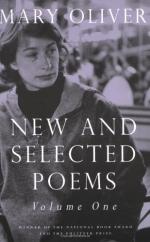
|
| Name: _________________________ | Period: ___________________ |
This test consists of 15 multiple choice questions and 5 short answer questions.
Multiple Choice Questions
1. What belongs to the animal in The Real Prayers are Not the Words, but the Attention that comes First?
(a) The water.
(b) The heavens.
(c) The earth and sky.
(d) The life it has claimed.
2. What kind of hands does Oliver hope to write her poetry with?
(a) Rough hands.
(b) Quiet hands.
(c) Useful hands.
(d) Busy hands.
3. What did Oliver say she was outside of while writing Work Sometimes?
(a) Her authentic self.
(b) Her usual style.
(c) Her natural setting.
(d) Her intended purpose.
4. What is Oliver trying to establish an intimacy with in Work Sometimes?
(a) Her God.
(b) A man.
(c) Herself.
(d) The reader.
5. What does Oliver call most of her poems?
(a) Observations.
(b) Creations.
(c) Statements of truth.
(d) Friends.
6. How does Oliver come to a better understanding of human nature?
(a) She observes the ocean tides.
(b) She meditates.
(c) She looks to non-human examples.
(d) She talks to people of different ages.
7. What did the animal in The Measure do when the poet tried to save it?
(a) Bit her.
(b) Ran away.
(c) Hissed at her.
(d) Looked into her eye.
8. How was the poet traveling when she saw an animal in The Measure?
(a) She was driving a car.
(b) She was swimming.
(c) She was riding a bike.
(d) She was walking along.
9. What kind of citizen did the poet call the animal in The Measure?
(a) Elderly.
(b) Voracious.
(c) Shy.
(d) Unknown.
10. In The Measure, what does the author say we must do to fully experience life?
(a) Help one another.
(b) Discard safety.
(c) Think of new directions.
(d) Give it a trial.
11. What animal was featured in The Measure?
(a) A squirrel.
(b) A rabbit.
(c) A box turtle.
(d) An armadillo.
12. What does Oliver try to avoid awkwardness in as she is writing?
(a) Format.
(b) Subject matter.
(c) Abbreviations.
(d) Symbols.
13. What does Oliver try to identify at the beginning of Work Sometimes?
(a) An identity.
(b) A happy memory.
(c) A memorable moment.
(d) A shared experience.
14. What were the feet of the animal compared to in The Real Prayers are Not the Words, but the Attention that comes First?
(a) Sand.
(b) The Sun.
(c) Flowers.
(d) Butter.
15. What else does the editor say there is an absence of in the first section of poems?
(a) Obscure references.
(b) Allusions.
(c) Confusing similes.
(d) Personification.
Short Answer Questions
1. What is the turtle in Mysteries, Four of the Simple Ones, doing?
2. Which of the following is a line from Work Sometimes?
3. How are the poems in this book grouped together?
4. What is the subject of Mysteries, Four of the Simple Ones?
5. What are most of the poems in this collection about?
|
This section contains 465 words (approx. 2 pages at 300 words per page) |

|




